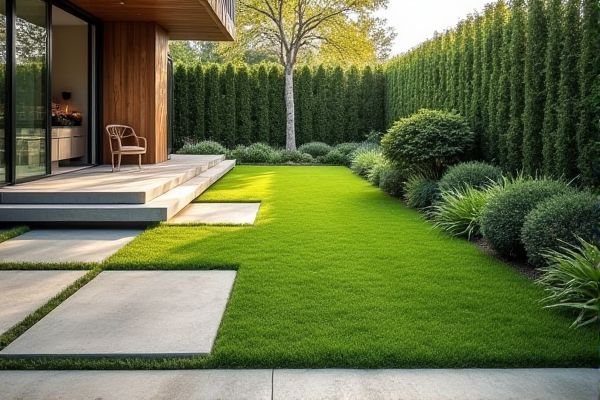
Deck tiles offer a stylish, durable surface that enhances outdoor spaces with natural textures like wood or stone, ideal for patios and balconies needing quick installation. Comparing deck tiles to artificial turf reveals distinct benefits for Your landscaping choices; explore the full article to determine which option best suits Your outdoor transformation goals.
Table of Comparison
| Feature | Deck Tiles | Artificial Turf |
|---|---|---|
| Material | Wood, composite, or plastic tiles | Polyethylene or polypropylene fibers |
| Installation | Easy snap-together or adhesive installation | Requires base preparation, infill, and securing edges |
| Maintenance | Regular cleaning, occasional sealing or staining | Minimal, occasional brushing and rinsing |
| Durability | Moderate to high, depends on material | High, UV and weather resistant |
| Appearance | Natural wood or modern composite look | Green, grass-like surface |
| Comfort | Hard surface, may be slippery | Soft and cushioned |
| Cost | Moderate upfront, varies by material | Higher initial cost, low maintenance |
| Eco-friendliness | Depends on wood source; composite may contain recycled materials | Generally non-biodegradable, but recyclable options exist |
Overview of Deck Tiles and Artificial Turf
Deck tiles offer a durable, customizable flooring solution made from materials like wood, composite, or rubber, ideal for creating stylish outdoor spaces with easy installation and maintenance. Artificial turf provides a low-maintenance, green surface resembling natural grass, perfect for areas requiring consistent greenery without watering or mowing. Your choice depends on desired texture, upkeep, and the aesthetic appeal you seek for your outdoor area.
Material Composition and Durability
Deck tiles are typically made from materials like wood, composite, or stone, offering high durability and resistance to outdoor elements such as UV rays, moisture, and temperature changes. Artificial turf is composed of synthetic fibers like polyethylene or polypropylene, designed to mimic natural grass while providing robust wear resistance and minimal maintenance requirements. Both options ensure long-lasting performance, but deck tiles generally offer superior structural strength, whereas artificial turf excels in flexibility and drainage.
Installation Process and Requirements
Deck tiles offer a straightforward installation process that involves snapping or clicking tiles into place on a flat, clean surface without the need for adhesives or specialized tools, making them ideal for DIY projects. Artificial turf requires a more detailed installation involving soil preparation, weed barriers, precise cutting, securing with nails or adhesives, and adding infill material to ensure durability and natural appearance. Your choice depends on whether you prefer the quick setup of deck tiles or the more intensive groundwork needed for artificial turf.
Maintenance and Longevity
Deck tiles require periodic cleaning and sealing to maintain their appearance and prevent weathering, typically lasting 10-15 years with proper care. Artificial turf offers low maintenance, needing only occasional brushing and rinsing, and can last 15-20 years without significant wear. Your choice depends on whether you prefer a more natural wood feel with upkeep or a durable, hassle-free surface.
Cost Comparison and Budget Considerations
Deck tiles typically cost between $20 and $50 per square foot, making them a more affordable option for small-scale projects, while artificial turf ranges from $8 to $20 per square foot but often requires professional installation, increasing upfront expenses. Maintenance costs for deck tiles are generally lower, mainly involving occasional cleaning, whereas artificial turf may incur ongoing expenses for infill replacement and antibacterial treatments. Budget considerations should include installation complexity, longevity, and upkeep to determine the most cost-effective solution for outdoor flooring needs.
Aesthetic Appeal and Design Options
Deck tiles offer a versatile aesthetic appeal with a variety of materials such as wood, composite, and stone, allowing for custom patterns, colors, and textures that enhance outdoor spaces with a natural or modern look. Artificial turf provides a consistently vibrant green appearance year-round, creating a lush and low-maintenance surface ideal for sports areas, playgrounds, or decorative lawns. Design options for deck tiles include modular installation and easy replacement, while artificial turf is available in different pile heights and densities to mimic natural grass closely.
Comfort and Practical Usage
Deck tiles offer a firm and stable surface that remains cool underfoot, ideal for placing furniture or walking barefoot comfortably. Artificial turf provides a softer, grass-like feel that cushions your steps and is low-maintenance, making it great for areas where natural grass is impractical. Your choice depends on whether you prioritize a durable, solid platform or a more natural, plush surface for relaxation and play.
Environmental Impact and Sustainability
Deck tiles made from sustainably sourced wood or recycled materials offer a lower environmental impact compared to artificial turf, which often involves non-biodegradable plastics and chemicals. Your choice can reduce landfill waste by selecting eco-friendly deck tiles that decompose naturally or are recyclable, unlike synthetic turf that contributes to microplastic pollution. Sustainable deck tile options promote better soil health and water permeability, supporting local ecosystems more effectively than impermeable artificial turf surfaces.
Ideal Applications for Each Surface
Deck tiles are ideal for creating durable, stylish outdoor patios, balconies, or rooftop decks where easy installation and a solid walking surface are priorities. Artificial turf excels in areas requiring low maintenance greenery, such as pet runs, playgrounds, or sports fields, providing a natural look without the need for watering or mowing. Your choice depends on whether you prefer a hard, decorative surface or a lush, grass-like area tailored to specific functional needs.
Pros and Cons: Deck Tiles vs Artificial Turf
Deck tiles offer quick installation, natural aesthetics, and durability, making them ideal for patios and balconies, but they may require regular cleaning and can become slippery when wet. Artificial turf provides a low-maintenance, green lawn appearance year-round and good drainage, yet it can get hot in direct sunlight and may not feel as natural underfoot. Your choice depends on whether you prioritize natural texture and design flexibility with deck tiles or the soft, evergreen look and ease of upkeep of artificial turf.
 homyna.com
homyna.com